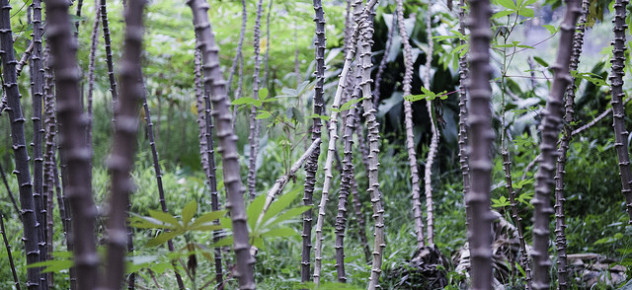
Cassava pink mealybug is capable of reducing cassava yields by up to 84%. Credit: Georgina Smith / CIAT
In a sting operation to combat invading pest species in Asia, researchers released around 3,000 tiny parasitic wasps in Indonesia during September 2014. The biological control operation is part of a major regional effort to stamp out a pest devastating cassava in Southeast Asia.
Cassava is a key crop in Indonesia, which is among the world’s major cassava producers. More than 1 million hectares of cassava are planted every year, half of which is directly consumed as a staple food. The crop is also used in the starch industry to make products as diverse as plywood, paper, sweeteners, and pharmaceuticals, thus providing smallholder farmers with a major market and source of income.
But the cassava pink mealybug (Phenacoccus manihoti) – one of the world’s most destructive cassava pests – has spread through the region, devastating Indonesia’s second major staple crop after rice, jeopardizing cassava-based livelihoods, food security, and the starch industry.
“Cassava directly supports millions of small-scale farmers in Indonesia and has enjoyed a period of being relatively pest-free from certain threats,” said Aunu Rauf, professor of agricultural entomology at Bogor Agricultural University in Indonesia, co-leading the wasp release with CIAT and the Food and Agriculture Organization of the United Nations (FAO).
“But now, pests have caught up,” he added. “We have to take rapid, environmentally sound measures to ensure livelihoods are protected and Indonesia’s food security is not compromised. If we don’t act now, this could be a major blow to the country’s cassava industry and to the millions of farmers who depend on this crop for their incomes,” he said.
Cassava pink mealybug is capable of reducing cassava yields by up to 84%. It was first reported in Thailand in 2008, subsequently spreading throughout the Greater Mekong Subregion.
Wasp ‘SWAT team’ to the rescue of Indonesian cassava crop: Jakarta (AFP) – An quot;eco-friendly SWAT teamquot;… http://t.co/ytEqa8Ns60
— News from Indonesia (@Indonesia_News) September 24, 2014
The tiny, 2-millimeter Anagyrus lopezi wasps deposit their eggs into the mealybug. The hatching larvae consume the mealybugs from inside, slowly mummifying and killing them. The first stage of the release inside a confined cage in an infected field allows researchers to ensure the wasps adapt to local conditions before an open-field release goes forward.

The tiny wasps deposit their eggs into the mealybug. The hatching larvae consume the mealybugs from inside, slowly killing them. Credit: Georgina Smith / CIAT
The wasps have already proven their economic clout in sub-Saharan Africa, where they saved a whopping US$20 billion in damages to the cassava industry and averted a food-security crisis for millions of smallholder farmers. The continent-wide release operation in the 1980s exceeded the cost of research by a factor of more than 200.
These wasps pose no threat to humans, animals, or other insects and feed only on cassava mealybug, according to researchers, and this method of biological control is better than sweeping fields with pesticides, which could have disastrous environmental impacts.
“Cassava is originally from South America, so it makes sense that the crop’s pests come from there too,” said Kris Wyckhuys, a CIAT entomologist. “With no effective threats or natural enemies to contend with, cassava mealybugs have lived in the lap of luxury, first in Africa and now in Asia. It’s time to help nature along and send in mealybugs’ natural parasitoid,” he added.

CIAT together with national and international partners will continue to develop resilient cassava varieties and integrated pest management systems. Credit: Georgina Smith / CIAT
A network of researchers spearheaded by CIAT and regional partners is staying ahead of the curve by investing in low-cost rapid pathogen detection kits, while gaining valuable insights into the biology and ecology of non-native cassava threats.
Throughout the world, invasive species have become a major threat to global economies, societies, and ecosystems. A diverse and growing group of invasive organisms is causing billion-dollar losses in direct management costs, in addition to inflicting substantial effects on the environment and trade.
“This sting operation gives the region’s cassava farmers a reprieve from a devastating pest. But we know it’s not the last such threat,” said Wyckhuys. “Scientists and farmers must continuously advance the science of crop production and protection to keep ahead of even the seemingly innocent mealybug.”
In the longterm, CIAT together with national and international partners will continue developing more resilient cassava varieties and better crop and integrated pest management systems as well as quarantine measures to stem the spread of pests and diseases in the region.